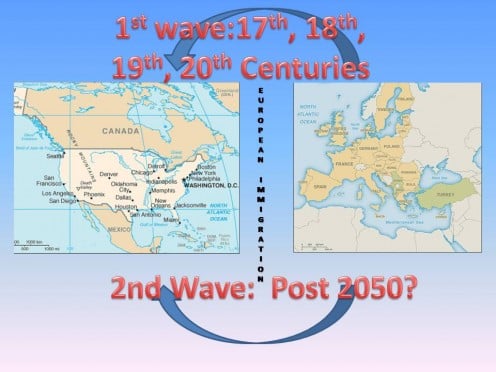The Next Wave: Immigration in the Late Twenty-First Century

The Next Wave: Immigration in the late Twenty-First Century
In the latter part of the 19th Century and the early 20th Century, America became home to millions of immigrants, many of them from Europe. There actually were quotas for immigrants from certain countries, favoring some over others:
“The United States experienced major waves of immigration during the colonial era, the first part of the 19th century and from the 1880s to 1920. Many immigrants came to America seeking greater economic opportunity, while some, such as the Pilgrims in the early 1600s, arrived in search of religious freedom. From the 17th to 19th centuries, hundreds of thousands of African slaves came to America against their will. The first significant federal legislation restricting immigration was the 1882 Chinese Exclusion Act. Individual states regulated immigration prior to the 1892 opening of Ellis Island, the country’s first federal immigration station. New laws in 1965 ended the quota system that favored European immigrants, and today, the majority of the country’s immigrants hail from Asia and Latin America.”[1]
The last sentence is referring to the massive wave of immigrants from Latin America, especially Mexico. Though the History.com article does not delineate, many Latin American “immigrants” entered the country illegally. As a result of this phenomenon, the argument rages today, especially after the election of Donald Trump who has promised stopping the influx and dealing with the illegal aliens already in the country. In any case, the overwhelming majority of people who have entered the US in the last half century are Hispanic.
“Across the pond,” in Europe, the source of so many immigrants to the US, the picture is quite different. In Great Britain, there has been for many years a large population of immigrants and their descendants from the subcontinent (India, Pakistan) and from the Middle East. Some British cities have huge populations of adherents to Islam, a source of constant irritation for many Brits who believe their country is being “overrun” with “foreigners” who do not assimilate into British society. On the continent, countries like the Netherlands, Belgium, Germany, France, and Sweden are dealing with the same issues, especially since the mass migration of refugees from the Syrian civil war. In southern Europe, “migrants[2]” are arriving en masse in Italy and Greece. From there, because of the Schengen Agreement, a treaty signed in 1985 which, for all intents and purposes, abolished internal border checks, many continue into central Europe, such as Germany which agreed to let in a large amount of “migrants.” This has caused a backlash from many Germans, some of whom have taken part in anti-immigrant demonstrations. Some eastern European nations, especially Hungary, Poland, and Slovenia, have pushed back on the influx, even to the point of erecting physical barriers to keep them out. The European Union (EU) has even threatened some countries with sanctions if they refuse to admit more “migrants:”[3]
Even a cursory examination of news stories coming out of Europe, especially those making the rounds on social media, will clearly show a major backlash against (1) the lack of assimilation of immigrants, legal and otherwise, and (2) the continuing influx of even more “migrants” coming in on a daily basis. Populist political parties have made inroads into European parliaments, although they are a long way from becoming majority parties. The problem is exacerbated by terrorist attacks by Islamic radicals and the constant demands by Muslims for the institution of Sharia law, the tenants of which are completely incompatible with Western democracy and traditions. Further, the demographics favor the immigrant populations, as most of the indigenous Europeans are not replacing themselves as quickly as non-European immigrants are. Some studies predict many of the European states will become Islamic republics by the middle of this century.
Assuming the EU does not reverse its policy toward mass migration and/or individual European nations start cracking down on the phenomenon (such as abrogating the Schengen Agreement and reestablish border controls), the face of Europe will change drastically over the next few decades. In prior centuries, European immigrants came to the US in droves, drawn by hope of a new life in the New World and escaping poverty back home, as well as religious strife and numerous European wars. This author maintains it is quite possible that a new influx of Europeans, -- Italians, French, Brits, Germans, Dutch, Swedes, Greeks, Poles and other eastern Europeans -- will once again arrive on our shores to get away from what some call the “Islamization” of Europe. [4] The effects of a second European migration on this country could be enormous. Would they be as welcome here as they were 100 to 150 years ago? Would there be a backlash from the nation’s significant Hispanic population? (American demographics are changing as well, with Caucasians becoming a minority by sometime in the latter half of this century.)[5]
Most of this is speculation but it is interesting to ponder the possibilities. Imagine a Europe dominated by Muslims, and an America with huge numbers of immigrants from what used to be known as the “old countries.” One country which has also had to deal with significant Muslim minorities is Russia. What would be the Russian reaction to a Muslim-dominated Europe? How about the former Eastern Bloc countries that are currently resisting the influx of “migrants?” Would many of them join their former western neighbors and “cross the pond” as well? Granted, such a mass migration could only happen, if happen at all, after huge upheaval in Europe brought on by a clash of cultures. The vast numbers of Europeans today are not in the same boat economically as were the majority of immigrants who came to Ellis Island, many of them crossing the Atlantic in steerage and carrying the sum total of their possessions. Nevertheless, this author could envision a situation where many Europeans could become fed up with their governments cowering In the face of threats from the EU. For that matter, another intriguing possibility is the potential disbanding of the EU as more and more countries start to resist the overbearing oligarchy the EU has become (consider Brexit as an example).
Again, just speculation on the author’s part, but the possibility of a second European mass migration is fascinating. Stranger things have happened.
[1] http://www.history.com/topics/u-s-immigration-before-1965
[2] As many of the people coming into Europe are not entering legally, the feeling of many Europeans is that the term “migrants” is actually a euphemism for what is in essence an invasion. The author concurs.
[3] http://www.dailymail.co.uk/news/article-4511928/EU-threatens-Poland-Hungary-SANCTIONS.html
[4] See for instance https://en.wikipedia.org/wiki/Stop_Islamisation_of_Europe
[5] http://nbclatino.com/2013/06/13/the-new-normal-asians-hispanics-will-soon-outnumber-current-white-majority/








